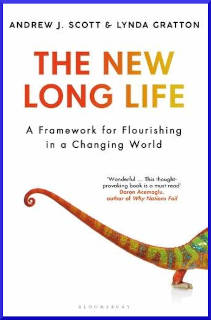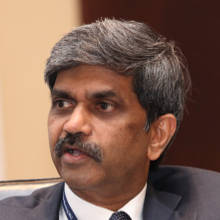The New Long Life
By Andrew Scott and Lynda Gratton
In their book ‘The New Long Life’, Andrew Scott and Lynda Gratton say, as individuals and as a society, we need to reimagine work, career, learning and relationships, among other things. And both the young and the old will need to share the burden and opportunities of longer lives
D ShivakumarBy Andrew Scott and Lynda Gratton

(1 of 49)
Human history is an impressive tale of collective achievement. Over thousands of years, we have substantially increased our numbers, our lifespan and the resources available to us. We are today far richer and far healthier as a consequence.
(2 of 49)
In every technological disruption, living standards failed to improve immediately. This was both an economic and a psychological burden.
(3 of 49)
Human ingenuity creates technological ingenuity; this needs social ingenuity to help the human lot.
(4 of 49)
We are in a period where the gap between technological ingenuity and social ingenuity is growing wider.
(5 of 49)
Media stories are full of warnings of job losses, 800 million jobs lost globally by 2030, more than half of US jobs at risk, etc.
(6 of 49)
By 2050, there will be 438 million Chinese above age 65. In Japan, 1 in 5 people will be over the age of 80.
(7 of 49)
Traditional models with traditional social structures are unlikely to work in the future. You will need courage and motivation to act on these.
(8 of 49)
Human beings have always used technology to make their own lives easier.
(9 of 49)
Gilder’s law predicts that bandwidth will grow at least three times the pace of computing power.
(10 of 49)
The word ‘robot’ was first introduced in Karel Capek’s 1920 sci-fi play R.U.R. The origins are from the Czech word robota, meaning forced labour or constant drudgery.
(11 of 49)
Today more than 2 million robots operate around the world, mostly in manufacturing, with the highest concentration in South Korea, which has 50 robots per 1,000 people.
(12 of 49)
Elon Musk says, “You cannot have people in an automated production line since you will drop to people speed.”
(13 of 49)
We have ‘pepper robot’ that work in banks welcoming customers. We have ‘hen – na’, a hotel robot; ‘sally’ is a robot that flips salads; and ‘botlr’ is a robot that provides extra towels and toiletries in a hotel.
(14 of 49)
For much of history, human ingenuity created technology that substituted physical power. We are now in a phase that augments or substitutes intellectual power.
(15 of 49)
Children born in the developed world have more than a 50% chance of living past age 100.
(16 of 49)
In 1950, there was not a single country where population declined. Between now and 2050, more than 50 countries will see population decline.
(17 of 49)
State pensions were first introduced by Bismarck in Germany in 1889, and were adopted by the UK in 1908 and the US in 1935.
(18 of 49)
We have to ensure that both the young and the old share the burden and opportunities of longer lives.
(19 of 49)
Economic fear underpins worries about robots. Society cannot afford long retirements amidst the growing proportion of old people.
(20 of 49)
We also work less now. In 1870 France, a work week was 66 hours. Today a work week in France is 36 hours.
(21 of 49)
Gary Kasparov, after losing to a machine in chess, said, “AI will change every aspect of our daily lives, but it won’t change our nature, it will reveal it.”
(22 of 49)
Beware that age-based prejudices aren’t just a prejudice against others, they are also a prejudice against your own future self.
(23 of 49)
The magic of compounding is not restricted to money. Other investments like skills, health, etc. also compound.
(24 of 49)
As Harvard economist Sendhil Mullainathan and Princeton psychologist Eldar Shafir have shown, when a resource is scarce, it dominates thinking and becomes the problem that needs to be fixed. The result of this tunnelling is that leaders become vulnerable to bad decisions that will be costly in the long run.
(25 of 49)
As we live longer, our careers will be longer and that creates opportunities to make trade-offs between time at work and time with family.
(26 of 49)
Thanks to productivity, people earn more, have time for leisure and overall have a better standard of living.
(27 of 49)
For many the decision to leave work is not made by them, it’s made by their company. Often the firm is downsizing or cost-saving.
(28 of 49)
Many older workers give up trying to look for a job after a few rejections.
(29 of 49)
Startup data
|
Age of entrepreneur when they started |
Highest growth startups |
All startups |
|
29 and below |
10% |
17% |
|
30-29 |
27% |
28% |
|
40-49 |
33% |
30% |
|
50 and older |
29% |
25% |
(30 of 49)
As we live longer, we need to think about how we form and sustain relationships.
(31 of 49)
The brilliance of the internet to match people with similar interests actually hurts diversity.
(32 of 49)
Our capacity to thrive and flourish depends on our families.
(33 of 49)
The various generations
(34 of 49)
The two loneliest groups are the young and the old. Society must forge bonds between these two groups.
(35 of 49)
Our community interactions are increasingly virtual. The average Facebook user spends 39 minutes on Facebook and 43 minutes face to face.
(36 of 49)
A hierarchical promotion structure blocks progress. The best example is Prince Charles who will be king in his 70s, the oldest monarch. Companies should learn to move people horizontally.
(37 of 49)
At ABB, as people approach 45, they are called to a seminar about their career development and possible milestones.
(38 of 49)
Fathers who contribute more to household chores and childcare experience a lower risk of divorce.
(39 of 49)
Looking forward, more working people will take time out to care for the elderly.
Most employees experience their workplace as relatively inflexible.
(40 of 49)
The real challenge is a shortage of companies willing to give older workers a chance. There is age bias.
(41 of 49)
Older workers tend to make small mistakes, while younger workers tend to make big mistakes at work.
(42 of 49)
To be fast and agile, employees need to be motivated and engaged.
(43 of 49)
Technology is transforming the workplace and is a key force in the design of work. Longevity is making people think hard about what constitutes work.
(44 of 49)
“The ‘learn it all’ will trump the ‘know it all’ in the long run.” - Satya Nadella
(45 of 49)
A team at Google analysed 100 senior managers and showed that the greatest contributing managers were good coaches, empowered others, were interested in the well-being of the team, were good communicators and good listeners, and had clear vision and strategy.
(46 of 49)
The cost of degrees has gone through the roof. US education debt stands $1.5 trillion.
(47 of 49)
In its purest form UBI (universal basic income) is a fixed sum of money that everyone in society receives irrespective of age, wealth or whether they are employed.
For some, UBI is not just a means of insuring those who lose their job, it is a way of liberating humans to focus on something more purposeful.
(48 of 49)
Globally we have one retiree to every worker, or a 0.25 % ratio. By 2100 this will reach 0.5 and in Japan it will reach 1.
(49 of 49)
Was this article useful? Sign up for our daily newsletter below
About the author

Shivakumar is Operating Partner at Advent International. Before this, he was President (Corporate Strategy and Business Development) at Aditya Birla Group. Earlier assignments include: Chairman & CEO at Pepsico India and prior to that, Managing Director at Nokia India. Before joining Nokia, he worked with consumer electronics maker Philips and top consumer goods firm Hindustan Unilever. He is an engineer from IIT Chennai and an MBA from IIM Calcutta.
Shivakumar has written three books: Reflections - a collection of Shivs articles; The Right Choice - Resolving Ten Career Dilemmas; and The Art of Management. The latter two are business bestsellers.
Also by me
Trending